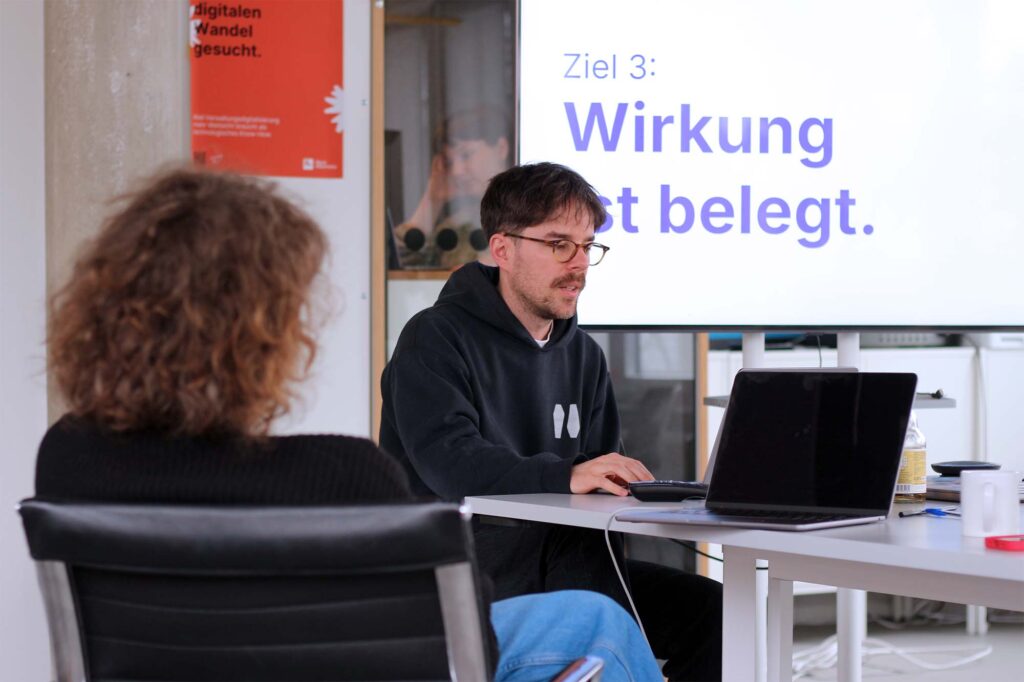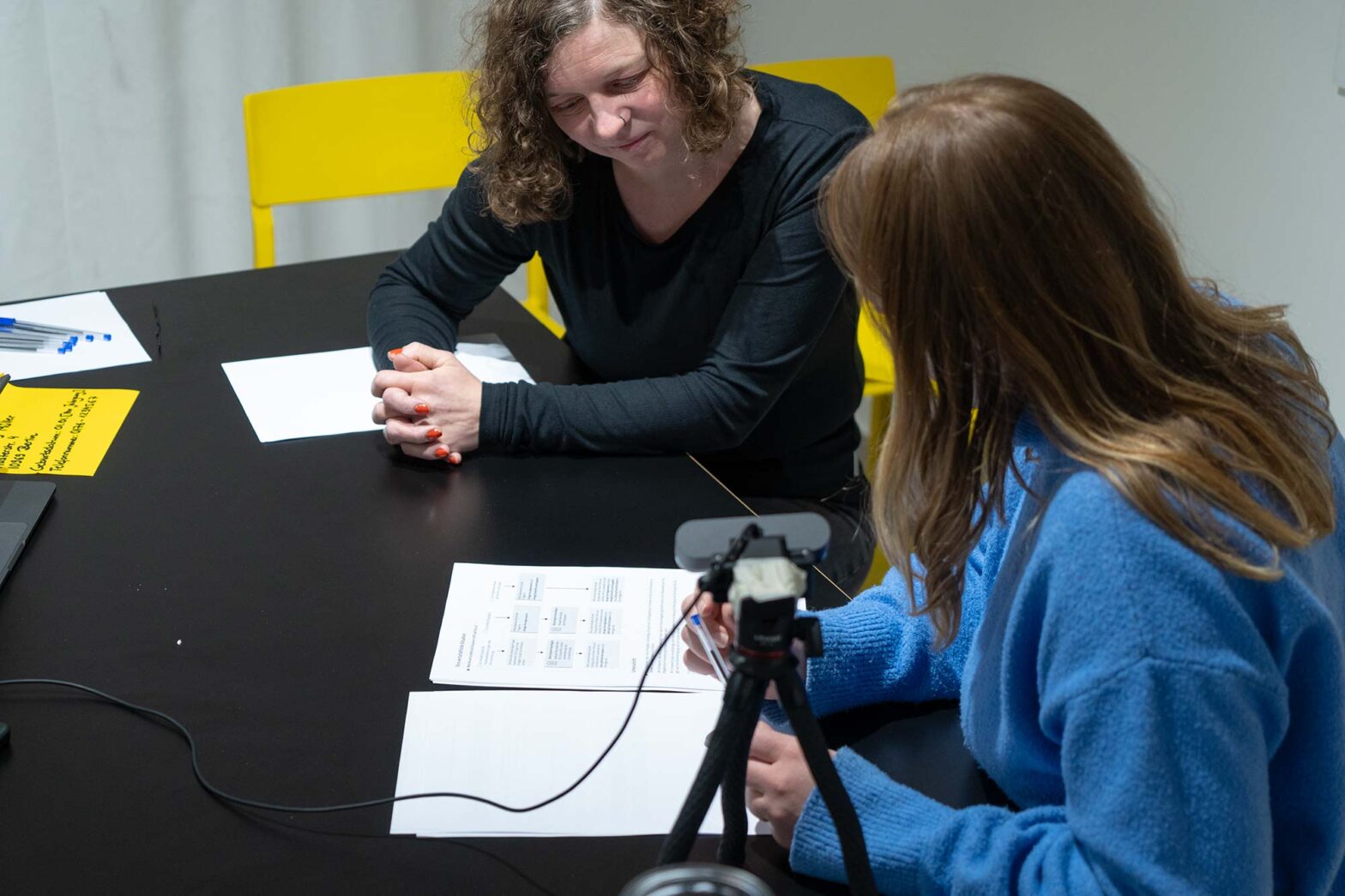Paper forms aren’t going away entirely—they can’t, for inclusivity’s sake.
As digital doesn’t equal online, our team has brought all the learnings from the legal aid online service to a vastly improved paper form.
On Wednesday and Thursday, they tested the latest version with 8 participants.
Germany’s legal aid online service has been available since last year. Our team first worked with the digital directorate at the Federal Ministry of Justice. Then, the policy directorate responsible for legal aid got interested in transferring the learnings to paper once the online service proved successful.
It was a good amount of work to structure the form so that it directs the users to meaningful sections depending on their circumstances—like ‘smart answers’ on paper.
Two QR codes on the first page also lead people to the online version of the service and its eligibility checker.
The team tried to balance length. In the 8 rounds, principal user researcher Sonja randomised the order, comparing the old and new versions of the form. There was a strong preference for the reworked form.
A new member of the ministry’s policy team responsible was in the first 3 user research sessions. He only wanted to stay around for the first one but then got so hooked that he called his boss and asked if it was OK to stay around for more sessions. That is what government transformation looks like in practice.
Doing hands-on work around service quality standards
While I carry many different plates at the moment, I got to be close to tangible project work again this week. I was note-taking in another interview on domain registration and some pains that come with it.
As content designer Linn joined the Service Standard, our small team workshoped itself into content review and creation. As the foundation for the updated standard, DIN SPEC 66366, was published last week, we can take the next steps. Those include describing each of the condensed 13 points in more detail: what they mean, why they matter and where people can get started.
For our little kick-off workshop on Wednesday, I made a short recap of how our previous GOV.UK Service Manual team was set up and worked. I contrasted more straightforward curatorial guidance work, like describing how to conduct an interview as part of user research, and more elaborative generative guidance work, like explaining how to initiate change to a policy to improve the service experience.

Participatory workshops with interested people from public sector organisations will continue in April. Like 5 years ago at GDS, we plan to take a community-led approach to guidance to ensure it lands and works for its audience.
Beyond that, a graphic I made for the Service Standard is now in use in presentations of the Federal Ministry of the Interior. Usually, the communications department purchases generic vector graphics from Adobe Stock and similar sources. I argued against using such generic material. As we have concrete artefacts in the making and the skills, a custom little graphic explains things better and hints at what’s to come. It’s not just decoration but a tiny story-telling device.
The visualisation includes a stylised poster of the updated and compressed standard, a sticker, a badge, a guidance page, an interactive tool and an assessment report page. These are all artefacts and touchpoints we are about to create.
Doing the math to argue for service transformation
Responding to questions about the investments into more quality services linked to the Service Standard, we see the need to provide more evidence of the value created. Critics have been citing some big numbers on the cost side. But they have not mentioned any benefits. That is what we are doing now.
Joshua and Jo have already created a robust cost-benefit analysis for the legal aid service, as mentioned 2 weeks ago. Now, my colleague Anna did the same for the parental benefit service. The spreadsheets and calculations they are currently building are more impressive than what I had seen from the in-house economists at GDS for value estimation back in 2019/2020.
Related, I was curiously digging into some numbers from colleagues abroad. I went through the archived GOV.UK Performance Platform to get some baseline for services’ completion rate. I found widely ranging numbers.
The completion rate for services seems to vary a lot. I went through the archived GOV.UK Performance Platform. DVLA’s “Personalised registration: put a registration number on a vehicle” service had a completion rate of 48.5% in 2021. MoJ’s “Bookings for prison visits” sat at a full 100%.
— Martin Jordan (@martinjordan.com) March 11, 2025 at 6:33 PM
[image or embed]
For GOV.UK services, I eventually found completion rates from somewhere around 32% to full 100%.
We can assume several factors affecting the diverging completion rates, including:
- clarity of the descriptions on a service’s start page
- existence of an eligibility checker before users enter the service
- overall quality and clarity of the service
- length of the form / transactional service journey
- kinds of and number of documents asked of the user
- criticality of the service – and hence, users’ motivation to overcome obstacles
Shifting the view back to German services, I tried to make sense of some published numbers. A dashboard for digital government services contains user feedback data from 3 out of 16 federal states. Based on some 786 data points from the past 3 months, the ease-of-use score is merely 1.9 out of 5. The numbers for individual states are as low as 1.4 even. Obviously, the quality of digital services is not at the level users expect it to be.
Data is good. Transparency is great. Action on insight is best. The German government runs an open dashboard for its online services. 3 out of 16 federal states report user feedback data. The ease-of-use score sits at 1.9 out of 5 stars 🌟 Much to do, I guess. dashboard.digitale-verwaltung.de
— Martin Jordan (@martinjordan.com) March 12, 2025 at 11:37 PM
[image or embed]
My colleagues Joshua and Robert will spend more time on this in the coming days. I will encourage them to write a proposal for this autumn’s Service Design in Government conference. In the context of external threats to our work, we need to have proper economic cases for our work at hand at all times.
Planning community activities ahead
The upcoming Service Gazette is properly in the works. Various contributors gave updates on their progress. One article draft already arrived ahead of our deadline next week.
Kara and I put together a short description of our opening talk at the Amsterdam conference. Our working title is ‘Protecting our practice: How to not let things get undone’.
The description we wrote now says this:
Over the past few years, we’ve seen government organizations increase their user-centred maturity – and then lose it again. More recently, we witnessed role-modelling organizations be dismantled. Denmark lost its groundbreaking innovation unit, Mindlab. In Canada, the Ontario Digital Service was shut down. Now, in the US, mass firings of digital specialists and the 18F team happened over night. We have been faced with the reality that government organizations do not mature and progress as we imagined them to. So, what does that mean for our work, practices and values? How do we navigate these times of disruptive change and rolling back from accessible, effective and better quality services? Any change of government or senior leadership can endanger our work and practices. In this talk, we highlight the stories of people who are still trying to make change from the inside of institutions who no longer advocate for digital and design specialists. We’ll leave you with some tips for how to brace for change or move through the change already here.”
In preparation for the talk in 3 weeks, we need to do some work. We feel the urge to reflect on recent events and discuss how to deal with what’s happening around us. We plan to speak to various people globally to inform our content.
In the meantime, Maria and I are planning an NExT user-centred design community gathering for mid-April. We will try to look at automation and benefits of artificial intelligence. We have shortlisted a few projects from across German government that might be good to hear and see more of.
Before that, we are planning our next local meetup open to the public. It’s the delayed event on ‘Checks & balances’ that we originally wanted to run in December. Due to the unavailability of speakers, we had to postpone it. With a few new speakers approaching, we hope to run it on 2 April. For the event after that, I have already made a draft of the poster for the May theme ‘Accessible for everyone’.
What’s next
Next week, we have a new starter, Zoé, joining us. She will be our first working student in a while and the first person in a user research operations role.
We will also prepare the employment contract for another designer we interviewed and made a verbal offer to. That means the user-centred design team will soon be 37 people. We could be scratching 40 by the end of the year.
Looking at the changing nature of our work, I will look into writing a short piece for the Service Gazette. It will discuss the more upstream legislative support work our service designers do as well as the tricky work on internal ‘enterprise’-level systems.

